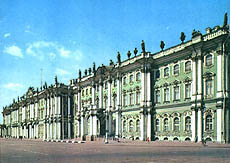Saint-Petersburg
 St. Petersburg was founded in 1703 by Russian Tzar Peter the Great to bring an unwilling Russian nation into the fold of Europe.
St. Petersburg was founded in 1703 by Russian Tzar Peter the Great to bring an unwilling Russian nation into the fold of Europe.
Unlike some cities, it was not created by a process of gradual, graceful development but was forcibly constructed, stone by stone, under the force and direction of Peter the Great, for whose patron saint the city is named. When it was nine years old it became the capital of Russia and retained this status till 1918. Even now it is referred to as the "Northern capital" of Russia. World class architects participated in the building of the city and today it remains an Imperial city of golden spires and gilded domes, of pastel palaces and candlelit cathedrals...
St. Petersburg is a fascinating place which dazzles the eye of a visitor with numerous architectural landmarks, museums, palaces, parks, wide avenues, spectacular bridges and stylish monuments. Born in the heart of an emperor, St. Petersburg is Russia's adopted child. So unlike the Russian cities that came before it, St. Petersburg - with its strict geometric lines and perfectly planned architecture - is almost too European to be Russian. And yet it is too Russian to be European. St. Petersburg is situated on 44 islands in Neva river's delta and is famous for its bridges, embankments, museums, and, of course, for its magical White Nights, which begins in the beginning of June and lasts up to the middle of July.
During the season of White Nights St.Petersburg undoubtedly is the most beautiful city in the world. The space needed to describe all the beauty of this city, known as the "Venice of the North", would fill unaccountable pages. The world famous "Hermitage" museum, "St. Isaac's Cathedral" - the second largest basilica in the world - and "Peter and Paul Fortress" resting place of the last Russian Tsar Nicolas II - are only three of the main architectural beauties to be seen and admired. In the summer - especially during the White Nights - you can enjoy the wonderful parks and gardens in the city with their statues and fountains.
There are 313 bridges in St.Petersburg, some of them are considered to be quite unique architectural constructions. The Population of St.Petersburg is about 5 million people. This is the second largest city in Russia (after Moscow) and the 19th in the world.
For two centuries St. Petersburg was the capital of Russia. The Russian Navy, the Academy of Sciences, the Academy of Arts, the first museums and the first theatres were all built on the banks of Neva. St. Petersburg is one of the biggest cultural and scientific centres in the world, the city with very rich history, traditions and promising future. There are about 120 museums, 40 theatres, 50 universities. Saint-Petersburg is also the home of the world-famous ballet-school. Their theatre performances will satisfy the highest of expectations.
"The most abstract and intentional city on earth"- to quote Fyodor Dostoyevsky - became the birthplace of Russian literature, the setting for Dostoyevsky's Raskolnikov and Pushkin's Eugene Onegin. From here, Tchaikovsky, Rachmaninov, Prokofiev, and Rimsky-Korsakov went forth to conquer the world with Russian music. It was here that great architects were summoned by 18th-century empresses to build palaces that transformed the city into a symphony of marble, malachite, and gold.
St. Petersburg is not just about its fairy-tale setting, however, for its history is integrally bound up in Russia's dark side too - a centuries - long procession of wars and revolutions. In the 19th century, the city witnessed the struggle against czarist oppression. Here the early fires of revolution were kindled, first in 1825 by a small band of starry-eyed aristocratic officers, the so-called Decembrists, and then by organized workers' movements in 1905.
The full-scale revolutions of 1917 led to the demise of the Romanov dynasty, the foundation of the Soviet Union, and the end of the city's role as the nation's capital.
But the worst ordeal by far came during World War II, when the city-then known as Leningrad-withstood a 900-day siege and blockade by Nazi forces.
Nowadays, St. Petersburg is a modern city and plays a very important role in Russia's political, scientific, and cultural life. It is really worth visiting it.
CITIES OF RUSSIA
Abakan I
Aginskoye I
Anadyr I
Arkhangelsk I
Astrakhan I
Barnaul I
Belgorod I
Birobidzhan I
Blagoveshensk I
Bryansk I
Cheboksary I
Chelyabinsk I
Cherkessk I
Chita I
Ekaterinburg I
Elista I
Gorno-Altaisk I
Groznyi I
Ioshkar-Ola I
Irkutsk I
Ivanovo I
Izhevsk I
Kaliningrad I
Kaluga I
Kazan I
Kemerovo I
Khabarovsk I
Khanty-Mansiysk I
Kirov I
Kostroma I
Krasnodar I
Krasnoyarsk I
Kudymkar I
Kurgan I
Kursk I
Kyzyl I
Lipetsk I
Magadan I
Maikop I
Makhachkala I
Moscow I
Murmansk I
Nalchik I
Naryan-Mar I
Nizhny Novgorod I
Norilsk I
Novgorod the Great I
Novosibirsk I
Omsk I
Orenburg I
Oryol I
Penza I
Perm I
Petropavlovsk-Kamchatsky I
Petrozavodsk I
Pskov I
Rostov the Great I
Ryazan I
Saint-Petersburg I
Salekhard I
Samara I
Saransk I
Saratov I
Smolensk I
Stavropol I
Syktyvkar I
Tambov I
Tomsk I
Tula I
Tver I
Tyumen I
Ufa I
Ulan-Ude I
Ulyanovsk I
Vladikavkaz I
Vladimir I
Vladivostok I
Volgograd I
Vologda I
Voronezh I
Yakutsk I
Yaroslavl I
Yuzhno-Sakhalinsk I
|